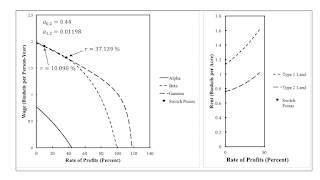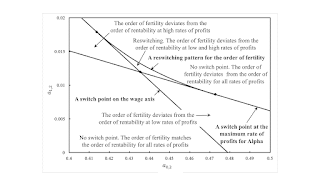Figure 1: An Example of the Reswitching of the Order of Fertility1.0 Introduction Nobody has ever pointed out the possibility highlighted by this post, as far as I know. This post can be contrasted with this one. Talk of "switch points" and "reswitching" for the wage curves on the left pane in Figure 1 above is, arguably, an abuse of terminology. Quantity flows do not change around the switch points. The same lands are fully farmed, and the same land that is partially farmed has the same quantity left fallow. This post presents a numerical example of extensive rent in which the order of rentability does not vary with distribution. Rent curves do not intersect. Yet the ranking of lands by fertility varies with distribution. The same order of fertility appears at low and high rates of
Topics:
Robert Vienneau considers the following as important: Example in Mathematical Economics, Joint Production, rent, Sraffa Effects
This could be interesting, too:
Robert Vienneau writes Austrian Capital Theory And Triple-Switching In The Corn-Tractor Model
Robert Vienneau writes Double Fluke Cases For Triple-Switching In The Corn-Tractor Model
Robert Vienneau writes The Emergence of Triple Switching and the Rarity of Reswitching Explained
Robert Vienneau writes Recap For A Triple -Switching Example
| Figure 1: An Example of the Reswitching of the Order of Fertility |
Nobody has ever pointed out the possibility highlighted by this post, as far as I know. This post can be contrasted with this one. Talk of "switch points" and "reswitching" for the wage curves on the left pane in Figure 1 above is, arguably, an abuse of terminology. Quantity flows do not change around the switch points. The same lands are fully farmed, and the same land that is partially farmed has the same quantity left fallow.
This post presents a numerical example of extensive rent in which the order of rentability does not vary with distribution. Rent curves do not intersect. Yet the ranking of lands by fertility varies with distribution. The same order of fertility appears at low and high rates of profits, with a different order arising for intermediate rates of profits.
2.0 TechnologyThe analysis of the choice of technique in models of extensive rent can be based on the construction of wage curves, even though the outer envelope does not represent the cost-minimizing technique. The orders of fertility and rentability are emphasized here. The order of fertility is defined for specified techniques, in which multiple qualities of land are used in each technique, and a single quality of land pays no rent. At a given rate of profits, the qualities of land are ordered by wages, with the most fertile land paying the highest wage. The order of rentability specifies the sequence of different qualities of lands from high rent per acre to low rent per acre. Both orders may vary with the wage or the rate of profits. Table 1 presents coefficients of production for an example.
| Input | Iron Industry | Corn Industry | ||
| I | II | III | IV | |
| Labor | 1 | a0,2 | 91/250 | 67/100 |
| Type 1 Land | 0 | 49/100 | 0 | 0 |
| Type 2 Land | 0 | 0 | 59/100 | 0 |
| Type 3 Land | 0 | 0 | 0 | 9/20 |
| Iron | 9/20 | a1,2 | 9/10000 | 67/1000 |
| Corn | 2 | 6/125 | 27/100 | 3/20 |
The amount of corn that can be produced is constrained by the available quantities of each type of land. Endowments of land and requirements for use must be among the givens to analyze the choice of technique in this example. Suppose the quantities of the different types of land and net output is such that all three types of land must be farmed. One type will be only partially farmed. The iron-producing process must be operated in each of the three economically viable techniques. Table 2 describes which type of lands are fully cultivated and which type of land is left partially fallow in each of the Alpha, Beta, and Gamma techniques.
| Technique | Land | ||
| Type 1 | Type 2 | Type 3 | |
| Alpha | Fully farmed | Fully farmed | Partially farmed |
| Beta | Partially farmed | Fully farmed | Fully farmed |
| Gamma | Fully farmed | Partially farmed | Fully farmed |
Prices of production are specified by a system of equations with one degree of freedom. Suppose a bushel corn is the numeraire. Let p be the price of a ton of iron; r the rate of profits; w the wage; and ρ1, ρ2, and ρ3 the rent per acre on Type 1, Type 2, and Type 3 lands. Prices of production satisfy the following system of equations:
((9/20) p + 2)(1 + r) + 1 w = p
(a1,2p + (6/125))(1 + r) + (49/100) ρ1 + a0,2w = 1
((9/10000) p + (27/100))(1 + r) + (59/100) ρ2 + (91/250) w = 1
((67/1000) p + (3/20))(1 + r) + (9/20) ρ3 + (67/100) w = 1
The following equation specifies that at least one type of land obtains no rent:
ρ1ρ2ρ3 = 0
Consider a solution of the above system of four equations with non-negative prices, rents, wage, and the rate of profits. Either the wage or the rate of profits is taken as given from outside this system. Such a solution defines prices of production, given, say, the rate of profits.
One can solve for prices of production for each technique. The left pane in Figure 1 depicts wage curves for each technique, as functions of the rate of profits.
4.0 The Choice of TechniqueThe managers of firms choose among techniques on the basis of cost, where the prices must be such that no land pays a negative rent.
At a given rate of profits, order the wage curves on the left pane in Figure 1 from high wages to low wages. This is the order of fertility, also known as the order of efficiency. In this example, the Alpha technique is always cost-minimizing. Given the rate of profits, one works down among wage curves from high wages to low wages until one finds the wage curve for a technique at which requirements for use can be satisfied by cultivating only lands that obtain a non-neagtive rent. In the example, in which all three types of land must be cultivated, at least somewhat, the inner frontier is the wage curve for the cost-minimizing technique.
For the parameters illustrated in Figure 1, the order of fertility is Type 2, Type 1, and Type 3 lands for low and high rates of profits. The order of fertility is Type 1, Type 2, and Type 3 lands for intermediate rates of profits. This is a numerical example of the reswitching of the order of fertility.
The order of rentability, as illustrated by the right pane in Figure 1, is Type 1, Type 2, and Type 3 lands for all rates of profits. Type 3 lands pay no rent. The order of fertility matches the order of rentability at intermediate rates of profits, but not outside the range defined by the switch points.
5.0 Perturbation of Selected ParametersFigure 2 shows a partition of part of the parameter space around the example illustrated in Figure 1. The rent curves do not intersect for any regions in this small two-dimensional slice of the parameter space. The order of rentability is such that Type 1 land pays more rent per acre than Type 2 land for any income distribution. Type 3 land pays no rent.
| Figure 2: A Portion of the Parameter Space |
The example illustrated is for parameters in the central region in Figure 2. Here, the order of fertility varies from the order of rentability at low and high rates of profits, but not for intermediate rates of profits. This intermediate region disappears at the partition between this central region and the region to the northeast. The two upper wage curves on the left in Figure 1 become tangent at a single rate of profits for points along this partition. Consequently, the order of fertility deviates from the order of rentability for any parameters in the region to the northeast.
Fluke cases partition the parameter space into regions among which the order of fertility varies. To the southwest in Figure 2, one switch point between the wage curves for Beta and Gamma has vanished over the wage axis, and the other is at a rate of profits exceeding the maximum rate of profits for Alpha. The order of fertility matches the order of rentability. The northwest and southeast also illustrate parameters for which the order of fertility varies with the rate of profits. The order of fertility varies from the order of rentability at one or the other extreme, as indicated.
6.0 ConclusionThe order of fertility can vary with the wage or the rate of profits. The order of rentability can also vary with the wage or the rate of profits. And they can vary from one another with distribution. The rate of fertility may vary with distribution, while the order of rentability stays constant, as in this post.
The reswitching of the order of fertility is not a fluke case. I do not think this example would surprise, for example, Heinz Kurz, Neri Salvadori, or Fabio Petri. Nevertheless, I think nobody has explicitly pointed out this possibility. Is this example "perverse" from the viewpoint of obsolete marginalist economics?
 Heterodox
Heterodox


